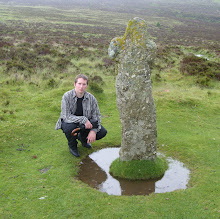


All welsh schoolchildren know the story of Brave Gelert. It is a popular children's picture book and was mentioned in a Victorian anthology of welsh folklore. So I was was somewhat disappointed to find out that it is probably a myth created by a local landlord trying to bring tourists to the area. Well it obviously worked and I was in the area, I was impressed by the atmosphere of the grave even if it is a fake. However the stones do look worn rather similar to the Rollrights, and no one seems to know what they really are or whose grave this actually is?
(If anyone has any clue, let me know)
GELERT'S GRAVE
IN THE 13TH CENTURY, LLYWELYN, PRINCE OF NORTH WALES, HAD A PALACE AT BEDDGELERT. ONE DAY HE WENT HUNTING WITHOUT GELERT "THE FAITHFUL HOUND" WHO WAS UNACCOUNTABLY ABSENT. ON LLYWELYN'S RETURN, THE TRUANT STAINED AND SMEARED WITH BLOOD, JOYFULLY SPRANG TO MEET HIS MASTER. THE PRINCE ALARMED HASTENED TO FIND HIS SON, AND SAW THE INFANT'S COT EMPTY, THE BEDCLOTHES AND FLOOR COVERED WITH BLOOD. THE FRANTIC FATHER PLUNGED THE SWORD INTO THE HOUND'S SIDE THINKING IT HAD KILLED HIS HEIR. THE DOG'S DYING YELL WAS ANSWERED BY A CHILD'S CRY. LLYWELYN SEARCHED AND DISCOVERED HIS BOY UNHARMED BUT NEAR BY LAY THE BODY OF A MIGHTY WOLF WHICH GELERT HAD SLAIN, THE PRINCE FILLED WITH REMORSE IS SAID NEVER TO HAVE SMILED AGAIN. HE BURIED GELERT HERE. THE SPOT IS CALLED BEDDGELERT




















